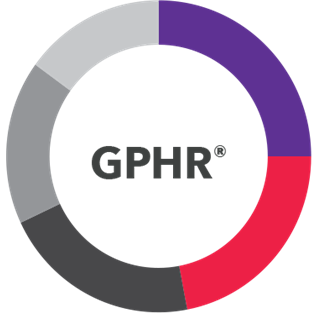
GPHR
Global Professional in Human Resources
Exam Topics

- Strategic Global Human Resources 25%
- Global Talent Management 20%
- Global Mobility 15%
- Workplace Culture 15%
- Total Rewards 15%
- Risk Management and Compliance 10%
Frequently Asked Questions…
Is this Certification Right for me?
Am I Eligible?
To be eligible for the GPHR you must meet one of the following conditions for education and experience:
- Have at least two years of experience* in a global professional-level HR position + a Master’s degree or higher,
- Have at least three years of experience* in a professional-level HR position (at least two in global HR) + a Bachelor’s degree, OR
- Have at least four years of experience* in a professional-level HR position (at least two in global HR) + a high school diploma.
*Note: Global HR experience is defined as having direct, cross-border HR responsibilities for two or more countries or regions
What Is the Exam Format & Length?
- Computer-based exam, at Pearson Vue locations
- Exam time: 3 hours
- Exam length: 140 multiple-choice questions + 25 pretest questions
What is Covered?
Review the GPHR Exam Content Outline for details.
How Do I Remain Certified?
How Much Does the Exam Cost?
Exam Fee*: $620
*Once an exam application is approved, no refunds will be made whether a candidate withdraws or no longer wishes to take the exam because the access code to the HR cannot be rescinded/de-activated.
When Can I Take the Exam?
Testing for the GPHR is available year-round, subject to availability at Pearson Vue locations
The Global Professional in Human Resources (GPHR®) exam is created using the GPHR EXAM CONTENT OUTLINE, which details the responsibilities performed by today’s HR professional. The GPHR EXAM CONTENT OUTLINE is created by HR subject matter experts through a rigorous practice analysis study conducted by HRCI. It is updated periodically to ensure it is consistent with current practices in the HR profession.
Functional Area 01 | Strategic Global Human Resources (25%)
Combining an understanding of global business factors and the unique HR challenges faced by such organizations while serving as a strategic business partner.
Responsibilities:
01. Participate in the development and implementation of the HR strategy to align with the global business strategy (e.g., evaluate local labor market conditions, regulation requirements, costs, language, barriers to entry, PESTLE analysis)
02. Implement workforce planning in alignment with the global business strategy (e.g., evaluate local labor market conditions, regulation requirements, costs, language, barriers to entry, PESTLE analysis, gap analysis output)
03. Prepare and execute elements of workforce restructuring in a global environment (e.g., local laws, risks, international laws, market practices, reputational risk, cost, training capabilities, labor relations, workplace culture, morale, systems, benefits, methodologies)
04. Design and execute a global HR delivery model (e.g., model – regional CoE, global CoE, business partnering, decentralized, local considerations – strategy, expertise, optimization, process improvement, cost savings, talent availability, language availability, time zone considerations – “follow the sun”)
05. Create and manage a global organization design (e.g., local rules on local managers, compliance, cultural differences, time zones, span of control, technology platforms for communications, language)
06. Describe the role, benefits, and limitations of outsourcing, offshoring, and shared services models (e.g., strategy, expertise, optimization, process improvement, cost savings, talent availability, language availability, time zone considerations – “follow the sun”)
07. Use common HR metrics to evaluate HR contributions to the achievement of the organization’s strategic goals (e.g., recruiting, cost per hire, engagement, employee net promoter score (eNPS), time to fill, return-on-investment (ROI), turnover rate, employee overseas assignment ROI)
08. Compare and contrast organic and inorganic (greenfield, brownfield, merger and acquisition) growth strategies from a global HR perspective
09. Determine and manage the HR processes during a merger, acquisition, or divestiture in a global organization (e.g., legal compliance, employee selection, resources, employee welfare, communications, buyer and seller obligations to employees, labor relations)
10. Apply various strategies for operating in countries with minimal headcount (e.g., PEO, use another country’s legal entity, purchase of an entity, partnership with local entity, establish a legal entity, representative office, joint venture)
11. Describe the role, benefits, and limitations of using a Professional Employment Organization (PEO)
Functional Area 02 | Global Talent Management (20%)
Using appropriate tools and metrics to ensure an organization is able to find, develop, engage and keep talent.
Responsibilities:
01. Evaluate the components of a talent management strategy (e.g., strategic employee planning, talent acquisition and retention, performance management, learning and motivating, total rewards, career development and succession planning)
02. Evaluate different approaches to sourcing talent at a global level (e.g., build/buy/borrow, internal/ external recruiting, internal transfers, recruitment process outsourcing (RPO), consultants, employee referrals, social media strategy)
03. Conduct and administer a global talent assessment (e.g., tools, methodology, assessor selection, cultural relevancy, unconscious bias, output, build/buy/borrow talent)
04. Evaluate the differences among various alternate work arrangements (e.g., job sharing, flexible schedules, telecommuting, virtual/remote, cross border) for a global workforce (e.g., cost compliance, productivity, effectiveness, technology, cultural, laws, retention strategy, work-life balance)
05. Identify the risks and benefits of leveraging nonemployees (independent contractors, consultants, third-party contractors) in a global organization (e.g., joint or co-employment, misclassification, financial risks such as owing backpay, legal risks)
06. Design and implement learning and development programs for a global workforce (e.g., language, culture, delivery method, learning styles, gap assessment, time zones, costs, tools, connectivity, technology)
07. Design and implement a performance management framework for a global workforce (e.g., goal setting, laws/regulations, strategy culture, systems/platforms, training, change management)
08. Use diagnostic tools in global organizations to assess employee engagement (e.g., exit surveys, onboarding surveys, engagement surveys, employee net promoter score, stay interviews)
09. Implement programs to improve employee engagement and retention in a global organization (e.g., peer recognition platforms, mentoring and coaching, communication or social platforms)
10. Evaluate the impact of employee organizations (works councils and local unions) on employees, business strategy, and practices, globally and locally
11. Evaluate the impact of the International Labour Organization (ILO), Organisation for Economic Cooperation and Development (OECD), and United Nations (UN) on employees, business strategy, and practice
12. Implement, integrate, automate, and maintain global HR systems and tools (e.g., data privacy, reporting, user experience, regulatory, automation, applicability, and effectiveness)
13. Manage employee data analytics and other emerging technologies in a global environment (e.g., different and relevant benchmarks, different countries, common definitions, different units of measurement, different industries, data privacy, selecting appropriate measures for outcomes)
Functional Area 03 | Global Mobility (15%)
Determining when to send employees abroad and ensuring smooth transitions for those on expatriate assignments and upon return, while ensuring compliance with applicable laws and regulations.
Responsibilities:
01. Analyze the role, benefits, and limitations of the various types of expatriate assignments (e.g., local plus, hybrid, long-term, short-term)
02. Compare and contrast the following employee types (e.g., host country national, parent country national, third country national, local national)
03. Facilitate the expatriation of an employee going on an overseas assignment (e.g., planning,communication, culture and language training, logistical support, integration, family acclimation, visa and immigration)
04. Assess and administer the demographic factors when selecting employees for an overseas assignment which may not normally be considered for a local position (e.g., religion, sexual orientation, family status, gender, gender identity, nationality, special needs, pets, cultural adaptability, and age)
05. Apply the primary incremental variables included in a cost analysis for an overseas assignment (e.g., immigration, relocation expenses, housing, car allowance, education allowance, home leave allowance, travel allowance, air travel to and from assignment, COLA, consulting fees, and taxes)
06. Recognize and articulate country-to-country differences (regulatory, statutory, and customary) in the hiring and onboarding process for expatriates (e.g., preemployment screening, personally identifiable information, preemployment health check, technological, benefits enrollment, offers vs employment agreements, orienting, immigration, visa, work permit requirements)
07. Identify the most common types of visas applicable to employees and their families who are working or traveling outside their home country
08. Identify the potential country-to-country differences (regulatory, statutory, and customary) in the offboarding process for expatriates (e.g., notice pay, removing from benefits, immigration, government notification, departure travel, return travel, labor organization notification, settlement agreements)
09. Plan and execute the successful repatriation of an employee on an overseas assignment (e.g., planning, communication, having a new position, integration, family re-acclimation, visa, immigration)
10. Describe the key considerations when localizing expatriates (e.g., housing, children’s education, compensation, visa and immigration requirements, migration to local salary and rewards, terms and conditions, portability)
11. Evaluate the primary considerations for a repatriate or expatriate and his/her family when preparing to relocate
Functional Area 04 | Workplace Culture (15%)
Maximizing organizational results by facilitating an inclusive workplace through cultural competence,
corporate social responsibility and ethical behavior.
Responsibilities:
01. Describe the cultural dynamics that may impact strategy and behavior in a cross-border context (i.e., Trompenaars and Hofstede)
02. Identify and apply the potential elements of cultural differences and norms when designing HR programs for a global workforce (i.e., Trompenaars and Hofstede)
03. Evaluate the key considerations to mitigate the risks and identify the opportunities for promoting diversity and inclusion in a global workforce (e.g., cultural, religious, social, political, legal, and special needs considerations)
04. Implement and maintain corporate social responsibility (CSR) and ethics program (e.g., employer branding and reputation, risk management, employee engagement, employee satisfaction, strategic partnerships/vendor requirements, cost, obligations, legal and statutory obligation, bribery and corrupt practices: US Foreign Corrupt Practices Act, Safe Harbor Privacy Principles, UK Bribery Act)
Functional Area 05 | Total Rewards (15%)
Providing voluntary and required total rewards appropriate for the work location and circumstances of employment.
Responsibilities:
01. Identify the most common total reward strategies and complexities of statutory and market requirements for local employees and/or expatriates from the perspectives of both the organization and the employee (e.g., health and welfare benefits, compensation, retirement, payroll, equity compensation and taxation, cost analysis, double taxation, totalization agreements)
02. Evaluate the key compensation philosophies of an expatriate package (e.g., host country, home country, Big Mac Index, COLA)
03. Identify the components of supplemental pay (e.g., per diems, hazard pay, hardship allowance, stipends) for local or expatriate employees
04. Identify the circumstances (e.g., political unrest, climate extremes, excessive crime, unusual work schedules) where supplemental pay may be required for local or expatriate employees
05. Compare and contrast the two primary retirement plan types (defined benefit and defined contribution), considering both statutory and voluntary schemes
Functional Area 06 | Risk Management and Compliance (10%)
Keeping an organization’s employees safe, secure and free of discrimination and harassment, while protecting privacy and ensuring compliance with applicable laws and regulations.
Responsibilities:
01. Determine the key considerations in developing and implementing a strategy to proactively manage physical safety and security risks for employees globally
02. Describe the resources commonly used to assess, mitigate, and manage security risks, incidents, and evacuations (e.g., kidnap and ransom insurance, travel and medical services)
03. Evaluate the types of controls in a global HR environment used to manage risk and maintain compliance (e.g., audits, segregation of duties, quality assurance, multi-level approvals, external accreditation, control or exception reporting)
04. Implement and maintain global anti-discrimination, anti-bullying, and anti-harassment policies (e.g., laws, processes, reporting requirements, representation, outcome/consequences, education, language, cultural norms)
05. Develop and execute a global employee investigation plan (e.g., investigator selection, laws, processes, timeline and reporting requirements, representation, outcome/consequences)
06. Identify the key principles of the General Data Protection Regulation (GDPR) (e.g., lawfulness, fairness and transparency, purpose limitations, data minimization, accuracy, storage limitation, integrity and compliance, accountability and compliance)